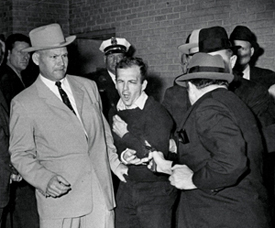March 14, 1964

Photo by Bob Jackson
Dallas nightclub owner Jack Ruby had long sought to make a name for himself, and he did so in grimly dramatic fashion when he gunned down Lee Harvey Oswald as he was being moved to the Dallas County Jail. In silencing JFK’s alleged assassin, Ruby helped foster a web of conspiracy theories centered on Oswald’s motives.
For his part, Ruby cast himself as an avenging patriot. And as the man who shot the man who shot the president, he seemingly expected to be treated leniently. His legal team, led by the flamboyant “King of Torts,” Melvin Belli, pursued an insanity defense based on the theory that Ruby acted in an impaired state due to a rare condition known as psychomotor epilepsy. The jury didn’t buy the theory and returned a guilty verdict, which carried with it a death sentence.
In October 1966, the Texas Court of Criminal Appeals reversed the conviction, holding that a change of venue should have been granted, and that Ruby’s statements to police after his arrest should have been ruled inadmissible. A second trial, scheduled to be held in Wichita Falls four months later, never took place, as Ruby died in prison on Jan. 3, 1967.



